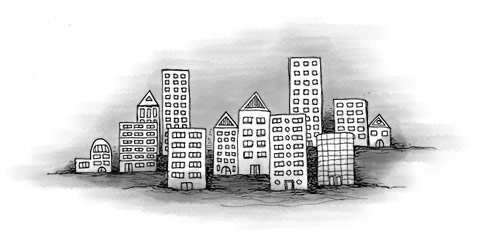In most countries an advertisement for a two room flat means a flat with two bedrooms, and most likely a kitchen and a bathroom. In the Czech Republic a two room flat will probably be a flat with two rooms (i.e. a bedroom and a kitchen, or a bedroom and a toilet, etc.)
Understanding Czech flat descriptions
There are several ways of advertising flats in the Czech Republic. Here is a short overview of what they mean most of the time.
1 + 1 This describes a flat with one bedroom and one other room. That other room would usually be a kitchen. A bathroom does not necessarily have to be included.
1 + kk Again, this describes a one bedroom flat. KK stands for a miniature kitchen which usually is not more than a hot plate and a sink.
1 + 0 This term may be used as synonym for 1 + kk. However, most of the time it describes one room only with no kitchen or bathroom whatsoever.
2 + 1 (3 + 1, 4 + 1, ...) This is a flat with two rooms and a kitchen (or three or four rooms respectively). A bathroom is normally included.
Although the terms are used universally, they do not always mean the same thing, so it is risky to rent a place without seeing it. You also need to watch out for poetic wordings in adverts when a property is being rented privately, especially if it is part of a house, converted garage, basement or garden house. The best advice is to make sure that you are very specific when asking what is actually included.
Another possibility to increase the attractiveness of a flat in an ad is to describe it as having a brand new bathroom or kitchen. When you get there you might find out that this will only be available on payment of 6 months’ rent in advance to cover for it. It will then be installed after you move in.
Moreover, don’t expect anything to be included in the apartment, unless it is specifically stated. Usually, there is also no kitchen at all and no lamps in the apartment. You will need to ask about every detail of the flat when contacting the lessor.
Types of houses and neighbourhoods
Panelaks: During the Communist era hundreds of thousands of panel block apartments, the panelaks, were built in the outskirts of nearly every major city. Apartments in these buildings look exactly the same all over the country – and even all over Eastern Europe – due to their construction by module principle. However, the condition of their interior may vary greatly, even within the same building. Since many of these apartment complexes have not been renovated after their construction, which may date back to the 1950s, their condition really depends on how the previous tenants have taken care of the flat.
Houses: Houses to rent are more likely to be found outside of the big cities and industrial centres in rural areas. They tend to have very thick concrete walls and small rooms, rather than fewer larger ones. After the fall of Communism, many flats and houses were subdivided to increase the availability of rental housing. Because of this, many small flats became even smaller, and family houses got split up to house two or three families.
Neighbourhoods: Neighbourhoods are very patchy in the Czech Republic. For example, a flat in an exclusive part of town can be just a block away from a really run-down area. You need to judge for yourself and have a walk around to get a feel for the location of an individual property.

